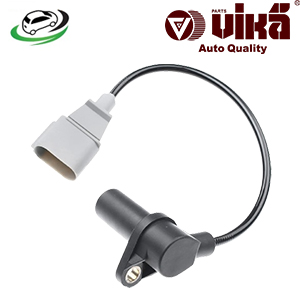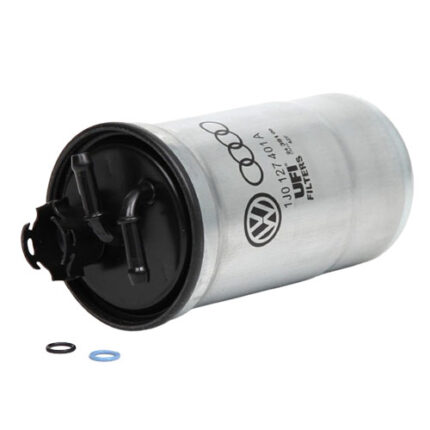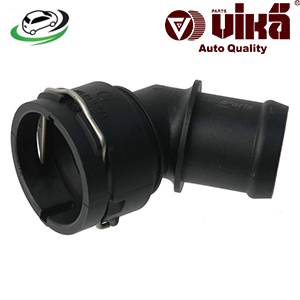-35%
Get Radiator Coolant Hose Connector VW Golf 1.8L/ Golf 1.9L/ Golf 2.0L/ GTI 1.8L/ GTI 2.0L/ Jetta 1.8L/ Jetta 1.9L/ Jetta 2.0L/ Jetta Wagon 2.0L 1J0122291
The radiator coolant hose connector is a small but essential component of a vehicle’s cooling system. It connects the radiator hoses to various parts of the engine, facilitating the smooth flow of coolant throughout the system. This guide provides a comprehensive understanding of the radiator coolant hose connector, including its purpose, types, construction, installation, and common issues.
The Role of the Radiator Coolant Hose Connector
The radiator coolant hose connector serves as a bridge between the hoses that carry coolant and the engine components that require cooling. Coolant is a liquid mixture, typically made of water and antifreeze, that circulates through the engine and radiator to absorb and dissipate heat. Without a properly functioning coolant system, the engine would quickly overheat, leading to serious damage.
The hose connector ensures that the coolant flows seamlessly between the engine, radiator, and other components such as the heater core. It plays a critical role in maintaining the integrity of the cooling system by preventing leaks and ensuring a secure connection between the hoses and their respective components.
Types of Radiator Coolant Hose Connectors
Radiator coolant hose connectors come in various types, each designed to meet specific needs and vehicle designs. The most common types include:
- Barbed Connectors:
- Design: Barbed connectors have ridges or barbs on their surface, which grip the inside of the hose when it is pushed over the connector. The barbs prevent the hose from slipping off, ensuring a tight fit.
- Usage: These connectors are commonly used in older vehicles or in applications where a simple and cost-effective solution is required. They typically require hose clamps to secure the connection further.
- Quick-Connectors:
- Design: Quick-connectors are designed for easy and rapid installation and removal of hoses. They often feature a locking mechanism that snaps into place, securing the hose without the need for additional clamps.
- Usage: These connectors are prevalent in modern vehicles due to their convenience and efficiency. They are often used in tight spaces where traditional hose clamps may be difficult to access.
- Threaded Connectors:
- Design: Threaded connectors have a screw-like design that allows them to be threaded into the engine or radiator. The hose is then attached to the connector, usually with a hose clamp.
- Usage: These connectors are often used in heavy-duty applications or in vehicles where a more secure connection is necessary. They provide a strong and reliable seal.
- Tee Connectors:
- Design: Tee connectors have a T-shaped design that allows coolant to flow in three directions. They are used to split or combine coolant flow between different parts of the engine.
- Usage: These connectors are used in complex cooling systems where multiple components need to be connected to the coolant flow.
- Elbow Connectors:
- Design: Elbow connectors have an angled design, typically 90 degrees, allowing hoses to be connected at an angle. This is useful in tight spaces where a straight connection would be impractical.
- Usage: These connectors are often used in areas of the engine bay where space is limited or where hoses need to be routed around other components.
Installation and Maintenance of Radiator Coolant Hose Connectors
Proper installation and maintenance of radiator coolant hose connectors are crucial for the longevity and efficiency of the cooling system. Here’s a step-by-step guide to installing and maintaining these connectors:
- Preparation:
- Tools and Materials: Gather the necessary tools, including pliers, screwdrivers, and hose clamps, depending on the type of connector being installed. Ensure that the replacement connectors and hoses match the specifications of the original parts.
- Drain the Coolant:
- Before removing any hoses or connectors, drain the coolant from the radiator to prevent spills. This is typically done by opening the drain valve at the bottom of the radiator.
- Remove the Old Connector:
- Use pliers or a screwdriver to loosen the hose clamp (if applicable) and slide it away from the connector. Gently twist and pull the hose off the connector. If the connector is threaded, use a wrench to unscrew it from the engine or radiator.
- Inspect the Hoses:
- Check the condition of the hoses for any signs of wear, cracks, or leaks. If the hoses are damaged, replace them along with the connector.
- Install the New Connector:
- Slide the hose onto the new connector, ensuring it fits snugly over the barbs or threads. If using a quick-connector, make sure it locks into place securely. If using a threaded connector, screw it into the engine or radiator until it is tight.
- Secure the Connection:
- If the connector requires a hose clamp, slide the clamp into place and tighten it securely using a screwdriver or pliers. Make sure the clamp is positioned correctly and does not pinch the hose.
- Refill the Coolant:
- Refill the radiator with the appropriate type and amount of coolant. Make sure to bleed the cooling system to remove any air pockets that may have formed during the installation.
- Test for Leaks:
- Start the engine and let it run until it reaches operating temperature. Check the area around the new connector for any signs of leaks. If any leaks are found, tighten the connections further or replace any faulty components.
Signs of worn out Radiator Coolant Hose Connectors
1. Coolant Leaks
- Visible Leaks: One of the most apparent signs of a worn-out coolant hose connector is a visible coolant leak around the connector area. You may notice coolant puddles under the vehicle, particularly after it has been parked for some time.
- Stains or Residue: Dried coolant can leave behind a white, green, or pink residue (depending on the coolant type) around the connector. This indicates that a leak has occurred and the connector or hose may be worn.
2. Cracks or Splits
- Physical Damage: Over time, the material of the connector, especially if it’s plastic, can become brittle and develop cracks or splits. This damage is often visible upon inspection and can lead to leaks or complete failure of the connection.
- Stress Marks: Before completely cracking, the connector may show stress marks or discoloration, especially at points where it connects to the hose.
3. Loose Connections
- Unstable Fit: A worn-out connector may no longer provide a tight fit, causing the hose to slip off easily. If you can move the hose or connector with minimal effort, it might be too loose and failing to maintain proper pressure.
- Vibration Issues: Loose connections can also cause vibrations, leading to further wear or even detachment of the hose while the engine is running.
4. Corrosion or Rust
- Metal Degradation: For connectors made from metal (such as aluminum, brass, or steel), corrosion or rust is a clear sign of wear. Corrosion can weaken the connector, leading to leaks or failure under pressure.
- Discoloration: Even before severe corrosion occurs, you may notice discoloration or pitting on the metal surface, which indicates the early stages of rust or corrosion.
5. Swelling or Softening of the Hose
- Hose Deformation: If the connector is damaged or leaking, the hose attached to it might become swollen, soft, or spongy. This can happen due to prolonged exposure to leaking coolant or excessive pressure caused by a faulty connector.
- Oil Contamination: In some cases, oil contamination from engine leaks can soften the hose material near the connector, leading to deformation and a compromised seal.
6. Coolant Odor
- Sweet Smell: Coolant has a distinct sweet smell due to the ethylene glycol or propylene glycol it contains. If you notice this smell, especially when the engine is hot or after parking the vehicle, it could be due to a leak from a worn-out connector.
- Burning Smell: If the coolant is leaking onto hot engine components, it may produce a burning smell, which is a sign that the connector or surrounding components are compromised.
7. Engine Overheating
- Temperature Gauge: A faulty or leaking coolant hose connector can cause a drop in coolant levels, leading to inefficient cooling and resulting in engine overheating. If you notice the temperature gauge rising above normal levels, it could be due to a worn-out connector.
- Steam from the Engine Bay: In severe cases, a damaged connector might cause enough coolant loss to produce steam from the engine bay, indicating that the cooling system is compromised.
8. Check Engine Light or Low Coolant Warning
- Dashboard Alerts: Some vehicles are equipped with sensors that monitor coolant levels and engine temperature. If a worn connector leads to coolant loss or overheating, it may trigger the check engine light or a low coolant warning on the dashboard.
- Diagnostic Trouble Codes (DTCs): When the check engine light comes on, a diagnostic scan may reveal trouble codes related to coolant system issues, which could be linked to a failing hose connector.
Common Issues with Radiator Coolant Hose Connectors
While radiator coolant hose connectors are designed to be durable and reliable, they can still experience issues over time. Some common problems include:
- Leaks:
- Cause: Leaks can occur if the connector is not properly secured, if the hose is damaged, or if the connector itself is cracked or corroded.
- Solution: Inspect the connection for any loose clamps, damaged hoses, or cracks in the connector. Tighten the clamps or replace the faulty components as needed.
- Cracking or Breaking:
- Cause: Plastic connectors are prone to becoming brittle over time, especially when exposed to extreme temperatures. This can lead to cracking or breaking.
- Solution: Replace any damaged plastic connectors with new ones, or consider upgrading to more durable materials such as aluminum or brass.
- Corrosion:
- Cause: Metal connectors, particularly those made from aluminum or brass, can corrode over time if exposed to coolant that is not properly maintained or if there is moisture in the engine bay.
- Solution: Replace corroded connectors and ensure that the coolant is clean and at the correct concentration to prevent future corrosion.
- Loose Connections:
- Cause: Vibrations from the engine or poor installation can cause connectors to become loose over time, leading to leaks or coolant loss.
- Solution: Regularly inspect and tighten connections as part of routine maintenance to prevent them from becoming loose.
Follow us on Facebook for more parts.



